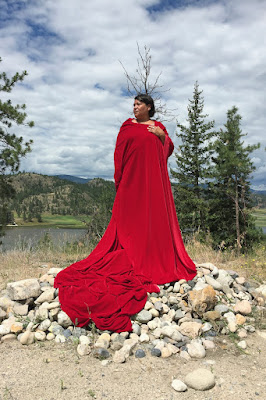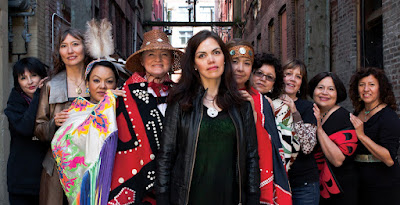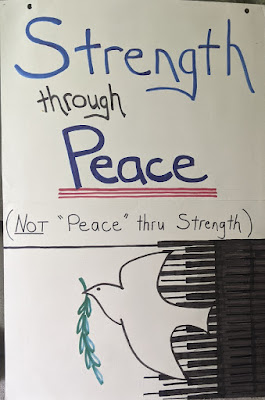Wednesday, October 06, 2021
Tuesday, October 05, 2021
[face equality]
Friday, September 17, 2021
[Indigenous art in the public eye]
 |
| Lori Blondeau, Asiniy Iskwew, 2016 |
Tuesday, September 14, 2021
a practical guide to the new world of pronouns
Here's a great learning opportunity that I've created for you -- a practical guide to the new world of pronouns.
This 36 minute video covers key topics like:
- Correct Pronouns Matter
- People Who Might Use Other Pronouns
- Pronouns for the New World We Live In
- Getting Practical About Sharing Pronouns
- Messing up with Grace
Link to watch directly at YouTube.com:
https://www.youtube.com/watch?v=BdtVLgU6OxA&t=6s
Tuesday, September 07, 2021
[feeling through - film]
This is a pretty cool short film, featuring an unhoused youth and a DeafBlind man.
"After a late-night chance encounter with a DeafBlind man on a New York City street, writer/director Doug Roland wrote the award winning short film, Feeling Through. Doug knew from the start he wanted to cast a DeafBlind actor to star, so he partnered with Helen Keller Services to realize that mission."
While casting a DeafBlind actor to play a DeafBlind character might seem like the logical thing to do, too often this does not happen and able-bodied people are cast to play disabled people.
Watch this short film and read more about it at: https://www.feelingthrough.com/
Monday, August 09, 2021
[evolution's rainbow]
Evolution's Rainbow: Diversity, Gender, and Sexuality in Nature and People
For a quick peek at what kinds of things this book talks about, check out this visual summary by @alokvmenon on Instagram:
Friday, July 02, 2021
bon repos
Friday, June 25, 2021
[he drew a circle...]
He drew a circle that shut me out -
Heretic, rebel, a thing to flout.
But love and I had the wit to win:
We drew a circle and took him in.
Edwin Markham1852-1940, "Outwitted"
(emphasis added)
Wednesday, June 23, 2021
march for peace
Wednesday, May 19, 2021
[celebrating Indigenous picture books]
I want to let you know about this amazing resource put out by International Board on Books for Young People (Canada) (IBBY) in 2018 - a catalogue of the 100 best of Indigenous picture books!
Plus, issued in June 2021, an additional catalogue of the best new 25 books!
From board books to picture books for older readers, this collection is a selection of 100 of the best books by Indigenous authors, many illustrated by Indigenous artists, published in Canada and currently in print. The titles reflect the diverse First Nations, Métis, and Inuit cultures, languages, perspectives, and experiences from sea to sea to sea. Attention was given to including picture books that promote and support Indigenous languages. All titles reflect authentic First Nations, Métis, and Inuit voices and offer insight into their distinct histories and current realities of these communities. (from IBBY website newsletter)
IBBY Introduction to the Catalogue
The Original "From Sea to Sea to Sea: Celebrating Indigenous Picture Books" Catalogue (PDF)
The 2021 "From Sea to Sea to Sea (2021 edition)" Catalogue (PDF)
IBBY Canada Special Edition Newsletter: From Sea to Sea to Sea: Celebrating Indigenous Picture Books
Monday, May 10, 2021
in memoriam: my dad, Richard Goetze
Tuesday, April 06, 2021
[LGBTQ2S artists from the north featured at Qaumajuq]
Wednesday, March 31, 2021
[Qaumajuq - "it is bright, it is lit"]
Thursday, January 07, 2021
tastawiyiniwak
Edmonton has recreated its electoral ward boundaries, and at the same time, named the new wards based on names gifted by the Committee of Indigenous Matriarchs.
I’d like to highlight one new ward in particular:
tastawiyiniwak - ᑕᐢᑕᐃᐧᔨᓂᐊᐧᐠ
You may have heard of the term “Two Spirit”, used to refer to Indigenous people who do not fit a Western gender binary and who had specific roles and responsibilities in their nations. The term is a cross-nation umbrella term for use only by Indigenous peoples, coined in contrast to Western labels and because many original Indigenous words have been lost due to the impact of colonization.
Tastawiyiniwak – pronounced TASS-TAW-WIN-EE-WOK – is the Cree-specific word for those who are Two Spirit. It means “the in-between people”, and “was only used when referring to all of the iskwêhkânak ekwah nâpêhkânak. Each was free to move between gender roles”.
To clarify, iskwêhkânak is the Cree word for “fake woman” (but without the negative connotations) and nâpêhkânak is the Cree word for “fake man”. Depending on the Cree nations, there were up to five additional words for gender beyond the “traditional Western” words male and female. Tastawiyiniwak is a word that refers to all Cree people whose gender roles are other than male or female.
So why was this name gifted to that particular new ward?
Terri Suntjens, Director of Indigenous Initiatives at MacEwan University, explains:
“We have grandmothers within our spiritual realm, within our ceremonies, that sit in different directions. We have the east, the west, the south, the north, the southeast. They each have different responsibilities. They look after different people and have different … responsibilities. And so, the grandmother that sits in the north direction, when the pipe is gifted and held up to the north, is the grandmother that takes care of our LGBTQ2S+ community” (shared at Edmonton Council meeting, Sept. 21, 2020)
For more information:
Wednesday, December 30, 2020
not "two sides of the same coin"
A little rant:
A common saying that I hear in organizations and companies is, "Diversity and Inclusion are two sides of the same coin".
Here's an example, from an article at the Alberta CPA website (but they aren't the only ones saying this):
Rubbish!
It is true that a coin has two sides and it's not possible to have one side of a coin without the other, but it is certainly possible to have diversity without inclusion.
Think of pre-apartheid South Africa -- there were white people and Black people (= diversity), but the Blacks were not included and the whites, though in the minority, held all the power (no inclusion).
Think of Canada - there is great diversity, but many minoritized people are excluded, some even from basic human needs like clean drinking water.
Think of your company or organization. There is probably much diversity among the employees overall, but most likely, the higher in the organizational structure you go, the more white, male and cisgender it gets. So clearly, there is not inclusion at those levels.















